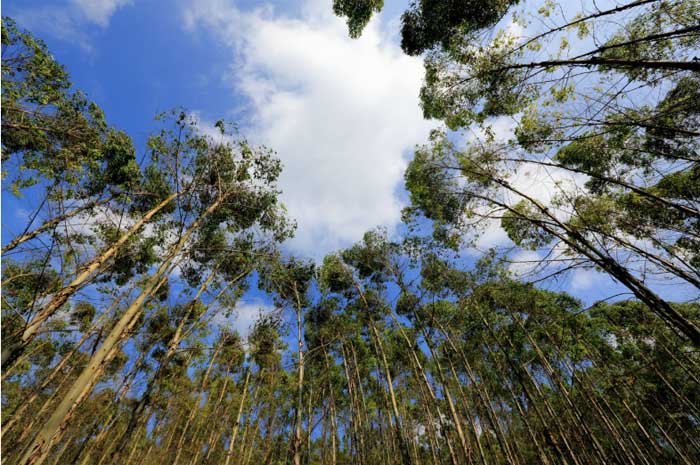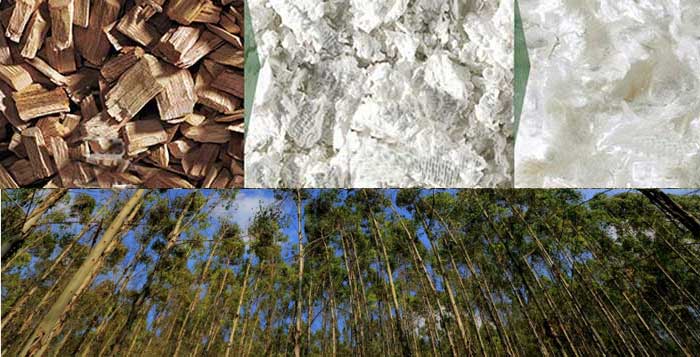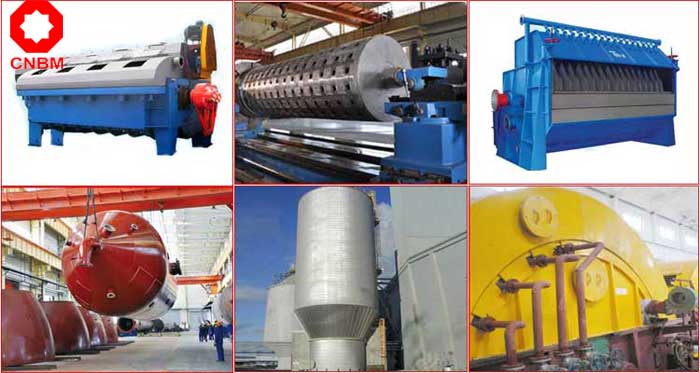eucalyptus pulp making
About eucalyptus and eucalyptus pulp
Eucalyptus has strong adaptability and rapid growth; it is tall and straight, has few pests and diseases, and has a wide range of uses; the main root penetrates deep into the ground and can absorb a large amount of groundwater. Eucalyptus belongs to hardwood and is a kind of wood pulp, but because of its low lignin content, it is easy to decompose water, and experiments have shown that it is also easy to cook and bleach. Eucalyptus is recognized as a high-quality wood in the pulp industry, and its planting cost is low and its economic benefits are extremely high. Eucalyptus requires very little material per ton of pulp to produce. Therefore, eucalyptus pulp for papermaking will have higher economic benefits. Eucalyptus wood pulp is an excellent short-fiber broad-leaved wood pulp. Because of its relatively uniform fiber, simple cell structure and low lignification degree, its smoothness, bulkiness, hiding power, softness and water absorption are all better than needle pulp. Leaf pulp. Eucalyptus pulp can be widely used in the manufacture of high-grade writing paper, copy paper, white cardboard, anti-counterfeiting paper, cigarette paper, toilet paper, napkin and other paper. According to the characteristics of eucalyptus fiber and pulp, eucalyptus pulp is suitable for making various grades of paper, especially when it is used with other pulp types, it can give full play to its advantages, but when using it, it should solve the problem of matching ratio.
Eucalyptus robusta Smith, also known as eucalyptus, has medicinal and economical value. Eucalyptus can be used for wood processing, charcoal raw materials, paper, essential oils, etc. Eucalyptus wood is heavy, hard and durable, especially resistant to corrosion and abrasion, making it a good hardwood. Pulp made from eucalyptus is not only better quality, but also has strong tear and tensile properties. It is worth noting that there are large differences in paper properties between different varieties. There are many kinds of eucalyptus, and eucalyptus papermaking needs to pay attention to the introduction and cultivation of eucalyptus.


Eucalyptus pulp processing
Existing eucalyptus pulping process has many kinds. Eucalyptus can be used to produce various chemical pulp, chemimechanical pulp and mechanical pulp. But it is mainly used to produce KP pulp. KP pulping of eucalyptus mainly uses NaOH and Na2S. The OH and HS in the cooking liquid will attack the sensitive structure in the lignin, and reactions such as alkalization and vulcanization will occur, and most of the lignin macromolecules will be decomposed into small molecules and dissolved, so that the raw materials will be dispersed into pulp. At present, about 75% of pulp in the world is made by kraft pulping. Kraft pulp paper has high strength, but low output and serious pollution.
Apart from this, there are many other pulping processes for eucalyptus such as RDH cooking, biopulp, bisulfite pulping, CMP, CTMP, BCTMP and APMP pulping.
The pulp production process is as follows:
Processes for pulping wood can be broadly classified as mechanical, chemical or semi-chemical. The pulp obtained according to different processes is called mechanical pulp, chemical pulp and chemical mechanical pulp.
The mechanical pulping method presses the wood section from the length direction onto a wet and rough grinding stone rotating at a constant speed, so that the fibers are separated from the wood section, and the pulp is made into pulp after being screened and concentrated. The pulp produced by the mechanical pulping method is called mechanical pulp, which has the characteristics of short fibers, low bursting strength, low whiteness but high yield.
The chemical pulping method immerses wood chips in an aqueous solution of appropriate chemicals, and cooks them under high temperature and pressure to dissolve the lignin in the wood chips to obtain complete cellulose, which is then made into pulp after subsequent processes. The pulp produced by this method is called for chemical pulp.

Kraft method and sulfite method are two basic chemical pulping methods, pulp made by kraft method is called kraft wood pulp, and pulp made by sulfite method is called sulfite wood pulp. In the 1930s, the kraft method began to gradually gain an advantage because it could use various types of wood that were not suitable for sulfite pulping. Therefore, the mainstream pulping companies now mostly use the kraft method to produce pulp.
Chemical pulp has long fibers and high burst strength, so it can be used in various applications.
Semi-chemical pulping combines chemical and mechanical methods. The wood chips are first partially softened or cooked with chemicals, and then the rest of the pulping is completed by mechanical methods. The pulp produced by this method is called chemical-mechanical pulp, which is mainly used for mixing with chemical pulp to make coated printing and writing paper, uncoated printing paper, etc. Writing paper and packaging paper and cardboard, etc.
Bleached kraft softwood pulp (hereinafter referred to as bleached needle pulp), the subject matter of pulp futures, adopts the chemical pulping method, and its industrial manufacturing process mainly includes raw material storage and chipping, cooking, washing, screening, bleaching, drying, slicing and packaging Waiting for the process.

In the specific manufacturing process, the whole tree length log is firstly taken, peeled and cut into smaller wood chips, and the qualified wood chips after screening are steamed with sodium hydroxide (NaOH) and sodium sulfide (Na2S) solution for 1 to 2 hours. Depending on the concentration of the effective chemical components in the cooking liquid, a part of the recovered cooking liquid may be supplemented to improve efficiency. The cooking process removes the lignin, breaking down the wood into cellulose fibers.
The coarse pulp after cooking is washed by a pulp washer, and the oversized fragments are removed by a screener to obtain a fine pulp. After the fine pulp is bleached and concentrated in multiple stages, it is made into a wet pulp board and sent to a dryer for drying. Finally, after slicing and baling, the resulting pulp can be delivered in the form of pulp bales.
The production process of wood pulp has the characteristics of circular economy, in which the recycling rate of water resources can exceed 90%. Organic matter can be used to burn electricity to achieve energy self-supply.
Different types of wood pulp, such as bleached needle pulp and bleached hardwood pulp, have basically the same production process. The main difference is that the production process of bleached needle pulp has an additional process of recovering turpentine compared with bleached hardwood pulp, and the parameter settings of the production process (such as cooking time) vary.
Therefore, a wood pulp production line can produce both bleached needle pulp and bleached hardwood pulp. However, the two kinds of pulp cannot be produced at the same time, and the production equipment must be fully cleaned, and the relevant parameters and part of the process must be changed before it can be used to produce another kind of pulp.

